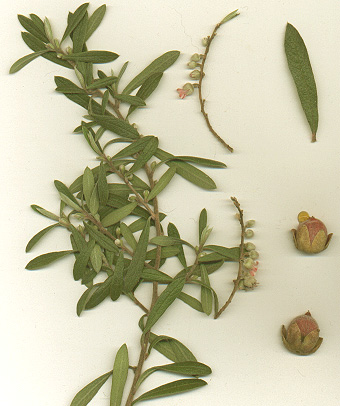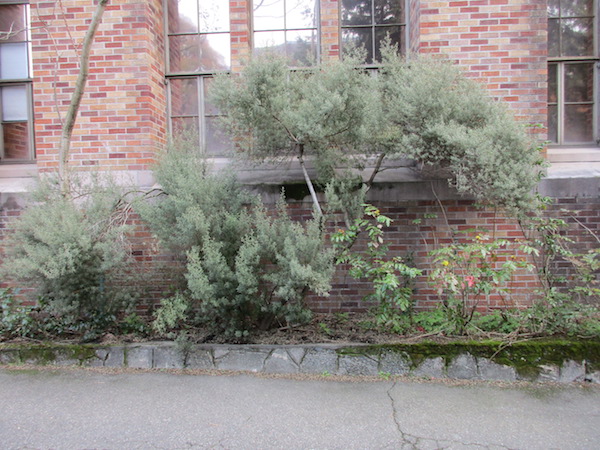Plant of the Month: March 2006
|
| South African Persimmon Shrub |
Diospyros austro-africana De Wint.
|
(EBENACEÆ); Ebony Family
|
| Proving experts wrong, or stumping experts, is usually a pleasure. It does not weigh as high as being in love or winning a grand prize, but does give a smug lift to those of us with an amateur or ordinary competence in a field of learning. I enjoy proving experts wrong. Nor do I mind it when I am proved wrong --it is a step in the direction of Truth. Recently I had an experience of proving myself wrong. It involved a plant that for years I swore was mislabeled. Yet this month I took a deep, long look at the plant, studied books in the library, and compared living specimens at the Berkeley Botanical Garden. Conclusion: I was wrong; The label was right. Here is the story. |
| In spring 1986 Art Kruckeberg, botany professor at the University of Washington, planted various shrubs and trees around the U.W. campus. These were all rare species that he had raised from seeds collected in his global travels. Many of these fresh plantings perished in the cold winter of 1989-90. Some are still alive. I may write of other species later, but this month focus only on one, Diospyros austro-africana. It grows on the west side of Bagley Hall, right next to the entrance. |
| It is a fine-textured evergreen shrub or small tree. The leaves are so small (the largest one and five-eighths of an inch long, and five-sixteenths of an inch wide --notably slender) and dense that it may be described aptly as looking nothing like its northern hemisphere kindred Diospyros virginiana L. (persimmon tree of the central and eastern United States) or Diospyros Kaki L. fil. (the Kaki or Japanese persimmon of NE India, Burma, China and Korea), and Diospyros Lotus L. (the Date-Plum of SW Asia all the way to Korea). These three trees are all deciduous, bear ordinary-size leaves, and their fruit is at least marble-sized. |
| The name Diospyros, is from Greek dios, divine, and pyros, wheat or grain; literally, celestial food --in allusion to the life-giving properties of the fruit. Most of the 500 or so species of Diospyros are heat-loving tropical species that cannot stand freezing weather. |
| Africa has about 90 species of Diospyros, including close relatives of the prized hardwood timber ebony, D. Ebenum Koenig. South Africa has various species. The one I am writing about was named originally Royena hirsuta L. in 1753 (non Diospyros hirsuta L. fil.) but was renamed D. austro-africana in 1961 by De Winter. It is a highly variable species, and some of its vernacular Afrikaans, Hottentot or other names include: kersbos (cherry berry), jakkalsbos (jackalbush --used also for D. mespiliformis Hochst. ex A. DC.), kraaibos (cow berry), kritikom (fire sticks --the most common name), kanobe, and senokonoko. From what I have learned it is a mere little shrub or rarely a small tree as tall as 30 feet. Individual specimens will bear male or female flowers. The Seattle example is female, and now 11.5 feet tall. Its fruits are fuzzy, dark red, seedy, at most half an inch wide, and not delectable. I doubt if an isolated specimen can set viable seeds even though it can produce some fruit. |
| The foliage is so hairy as to appear relatively dull. The flowers are small, clustered, creamy, pink or red but not very showy. The fruit is set sparingly, and is not especially winsome. So, the plant offers mainly curiosity value in being a relatively cold-hardy woody plant from South Africa. Most South African woody plants, especially trees, stand nary a chance to live long outside in frost-prone places such as Seattle. |
| In the Berkeley Botanical Garden there are two specimens of D. austro-africana with the same accession number: 76-0705. The tallest is only 6 feet, and they are perhaps both males --none had fruits this month, anyway. They are dull gray-green shrubs that could serve as garden background material for colorful perennials or annuals. To call either a tree would be worse than optimistic; it would be an incredible stretch. Since the Seattle specimen is both younger and taller, maybe it will grow eventually into a small tree. (Nope. It was savagely hacked back by someone with a saw in about January 2009.) To see seven photographs of the species taken in South Africa, visit this web page: (www.sophy.u-3mrs.fr/Afriqsud/SI327.HTM) |
| Seattle winters permit more than a few South American woody plants to do reliably well in cultivation here. And we have off and on success with Australian and New Zealand trees and shrubs. But South African woody plants have been tried sparingly here. At the moment those that come to mind are Rhus lancea L. fil., Rhus pyrodes Burch., Leucosidea sericea Eckl. & Zeyh., Widdringtonia Schwarzii (Marloth) Mast., Erica caffra L., Combretum erythophyllum (Burch.) Sond., and Myrsine africana L. Certainly others have been tried in Seattle, including species of Acacia and Podocarpus. Many South African woody plants are cultivated in southern California, where houseplants survive outdoors. |
The South African cold-tenderness explanation includes the fact that South Africa is surrounded by so much cold-buffering ocean that the cold weather is mitigated greatly and is not as enduring or damaging as what we routinely suffer in the North. Also, South Africa is not as far south (i.e., near Antarctica) as South America or New Zealand. Nor are its mountains so high. So South African plants are just not adapted to severe cold.
Back |

Diospyros austro-africana scan by ALJ |

Diospyros austro-africana photo by ALJ |
|
|

